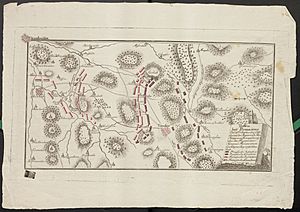Battle of Pirmasens facts for kids
Quick facts for kids Battle of Pirmasens |
|||||||
|---|---|---|---|---|---|---|---|
| Part of War of the First Coalition | |||||||
 Troop movements during the battle of Pirmasens 1793 |
|||||||
|
|||||||
| Belligerents | |||||||
| Commanders and leaders | |||||||
| Units involved | |||||||
| Strength | |||||||
| 8,000, 58 guns | 12,000, 36 guns | ||||||
| Casualties and losses | |||||||
| 167 | 4,000, 19–22 guns | ||||||
The Battle of Pirmasens happened on September 14, 1793. It was a fight between the French army and the Prussian army. The French troops were led by Jean René Moreaux. The Prussian forces were commanded by Duke of Brunswick.
The Prussians had set up their positions carefully. They were able to trap the French in a deadly crossfire. This forced the French soldiers to retreat. The battle was a clear victory for the Prussians.
This battle was part of the War of the First Coalition. This larger conflict was itself part of the French Revolutionary Wars. In 1793, Pirmasens was a town in a place called the Landgraviate of Hesse-Darmstadt. Today, Pirmasens is in the state of Rhineland-Palatinate in Germany. It is about 34.4 kilometers (21.4 miles) south of Kaiserslautern.
Contents
The Battle of Pirmasens: A Closer Look
The Battle of Pirmasens was a key moment in the War of the First Coalition. It showed how important good planning and strong defenses were in warfare.
Prussian Forces and Strategy
The Prussian army had about 8,000 soldiers. They also had 58 cannons, which are very powerful guns. Their army was divided into two main groups.
- One group was led by General-Leutnant Ludwig Karl von Kalckstein. This group included several battalions of infantry (foot soldiers).
- The other group was under General-major Prince Charles Louis of Baden. This group also had infantry. It included cavalry (soldiers on horseback) like Cuirassiers, Dragoons, and Hussars.
The Prussians chose their positions wisely. They waited for the French to attack. Their plan was to use their cannons and soldiers to fire from different directions. This created a "crossfire" that was very dangerous for the attacking French.
French Attack and Retreat
The French army was larger, with about 12,000 soldiers. They had 36 cannons. Their attack was organized into three columns.
- The Right Column was led by Paul Guillaume.
- The Center Column was directed by François Xavier Jacob Freytag.
- The Left Column was under Louis Lequoy. This column mainly consisted of cavalry, like Chasseurs à Cheval and Dragoon regiments.
The French tried to push forward. However, the Prussian defenses were too strong. The French soldiers faced heavy fire from all sides. They suffered many losses. Because of this, the French were forced to pull back their troops.
Outcome and Impact
The Battle of Pirmasens was a clear victory for the Prussians. They had far fewer casualties (soldiers lost) than the French. The Prussians lost about 167 soldiers. The French, however, lost around 4,000 soldiers. They also lost many of their cannons.
This battle showed the strength of the Prussian army's defenses. It was an important win for the forces fighting against the French Republic during this time.

